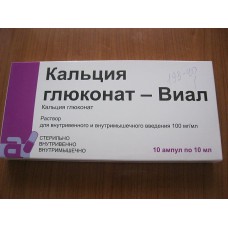Expiration date: 03/2026
Release form
Solution for injection
Composition
1 ml of solution contains: calcium gluconate 0.1 g.
Packaging
10 vials of 10 ml.
Pharmacological action
Calcium ions participate in the transmission of nerve impulses, the contraction of smooth and skeletal muscles, functioning of the myocardium, blood clotting, they are necessary for the formation of bone tissue, the functioning of other systems and organs. The concentration of calcium ions in the blood is reduced in many pathological processes, and expressed hypocalcemia contributes to the emergence of tetany. Calcium gluconate, besides eliminating hypocalcemia, reduces vascular permeability, has anti-allergic, anti-inflammatory, hemostatic effect. Unlike calcium chloride has a weaker local irritating effect, so it can be used for intramuscular and subcutaneous administration.
Testimony
- Insufficient function of parathyroid glands.
- Increased excretion of calcium from the body.
- As an adjuvant in allergic diseases and allergic complications of drug therapy.
- To reduce vascular permeability in pathological processes of various origins.
- Parenchymatous hepatitis.
- Toxic liver damage.
- Jade.
- Eclampsia.
- Hyperkalemia.
- Gipercalziemicescoy form of paroxysmal mioplegii.
- Skin diseases(as a styptic).
- Poisoning by magnesium salts, oxalic acid or its soluble salts, soluble salts of fluorine acid (as an antidote).
Contraindications
- Tendency to thrombosis.
- Hypercalcemia.
- Severe atherosclerosis.
- Increased blood clotting.
Application of pregnancy and breastfeeding
Application of Calcium gluconate-vial pregnant and breast-feeding is not contraindicated in therapeutic doses.
Method of application and doses
Intravenously and intramuscularly, Calcium gluconate-vial is administered 5 - 10 ml of 10% solution once, depending on the nature of the disease and the patient - every day, every other day or every 2 days. Children injected drug is not recommended due to possible development of necrosis. Children intravenously, depending on age, 10% solution of calcium gluconate administered in these doses: up to 6 months 0,1 - 1 ml, 7-12 months 1-1,5 ml, 1-3 years 1.5 - 2 ml, 1-3 years 1.5-2 ml, 4-6 years 2-2,5 ml, 7-14 years to 3-5 ml.
Side effects
Bradycardia, nausea, vomiting, diarrhea, tissue irritation (with the/m introduction - necrosis).
Special instructions
Not recommended in/m introduction to children. Syringe-fill should not contain alcohol residue. Ability at/in the introduction to cause a burning sensation in the oral cavity, and then heat all over the body previously used in the determination of the flow velocity (the difference in time between the introduction and emergence of the feeling of heat).
Drug interactions
Before filling solution of calcium gluconate syringe, the latter must not contain residues of ethyl alcohol (loss of gluconate in the sediment). Not recommended in conjunction with other drugs of calcium . Intravenous calcium gluconate before and after taking verapamil reduces its hypotensive effect, but does not affect its antiarrhythmic effect. With simultaneous use with quinidine may slow intraventricular conduction and increase toxicity of quinidine. During treatment with cardiac glycosides parenteral administration of calcium gluconate is not recommended because of increased cardiotoxicity. Simultaneous oral administration of calcium gluconate and tetracyclines, the latter may be reduced in connection with the reduction of their absorption.
Overdose
Symptoms: in overdose may develop hypercalcemia.
Treatment: in this case, the antidote used is calcitonin, which is injected intravenously at the rate of 5-10 IU per 1 kg of body weight per day (the drug is diluted in 500 ml of isotonic sodium chloride solution, introducing drip for 6 hours 2 - 4 admission).
Storage conditions
In the dark place at a temperature below 25 °C.
Shelf life
2.5 years.


